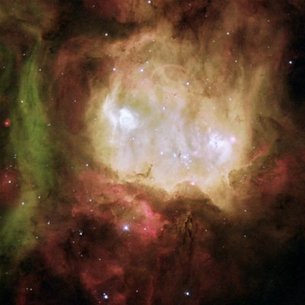 |
| M42 Orion nebula kuva NASA APOD |
Maailmankaikkeus säteilee valoa. Siellä ajalehtivat valtaisat vetymolekyylipilvet (H2) säteilevät syntyvien tähtien ja muun avaruustuulienergian voimalla h-alfa valoa.
ESA selittää kaikkeuden valojen värejä
 |
| NGC 2080 "Aaveen pää nebula" kuva Hubble teleskooppi NASA/ESA |
The Hubble image shows the nebula NGC 2080, nicknamed the 'Ghost Head Nebula' by astronomers. It is one of a chain of star-forming regions lying south of the 30 Doradus nebula in the Large Magellanic Cloud that have attracted special attention. These regions have been studied in detail with Hubble and have long been identified as unique star-forming sites. 30 Doradus is the largest star-forming complex not only in the Large Magellanic Cloud, but also in the whole local group of galaxies.
The light from the nebula caught in this image is emitted by two elements, hydrogen and oxygen. The red and blue light comes from regions of hydrogen gas heated by nearby stars until it is fully ionised. The green light of the filament shape on the left comes from doubly ionised oxygen. The energy to illuminate the filament is supplied by a powerful stellar wind coming from a massive star just outside the image. The white region in the centre is a combination of all three emissions, and indicates a core of hot, massive stars in this star formation region. The intense emission from these stars has carved a bowl shaped cavity in the surrounding gas.
lue koko artikkeli Painting with oxygen and hydrogen ESA
Ei kommentteja:
Lähetä kommentti